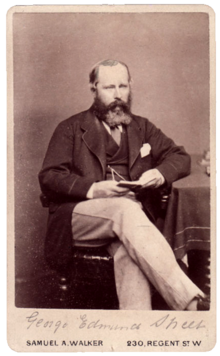George Edmund Street
George Edmund Street (born June 20, 1824 in Woodford , † December 18, 1881 in London ) was a British architect who designed mainly church buildings in the neo-Gothic style and is the architect of the Royal Courts of Justice in London.
Street was the son of a lawyer. He went to school in Mitchum and the Camberwell Collegiate School, worked for a short time for his father and after his death moved to his mother and sister in Exeter. Because he was interested in architecture, his mother placed him in 1841 with the architect Owen Browne Carter in Winchester. He then spent five years with George Gilbert Scott in London, where he designed, among other things, the church of Biscovey in Cornwall. In 1849 he opened his own architectural office in Cornwall, which mainly renovated churches. In 1850 he became an architect for the Diocese of Oxford and moved to Wantage and in 1852 to Oxford. He made the church of St. Philip and St. James in Oxford and the renovation of the chapel of Jesus College. During this time he represented conversions in the sense of the early Gothic (England, France 13th century) and was an opponent of a style that was too eclectic. At first he also painted the walls of churches himself, but soon afterwards had no more time. In 1855 he moved back to London.
Unrealized designs were his contribution to the competition for Lille Cathedral (second prize), for the Foreign Office in Whitehall and a new building for the National Gallery. In the competition for the Crimean Memorial Church in Istanbul, he received second place, but his design was implemented.
He traveled extensively in Europe to study Gothic architecture and was an excellent draftsman. He wrote an illustrated book on brick and marble constructions in Northern Italy (The Brick and Marble Architecture of Northern Italy, 1855) and Gothic architecture in Spain (The Gothic Architecture of Spain, 1865). He initiated a multicolored variant of neo-Gothic in Great Britain, for example with alternating red and black bricks. This use of non-English stylistic elements was supported by the critic John Ruskin (who favored the northern Italian Gothic) and by the writings of Eugène Viollet-le-Duc . But he also built, for example, in the Romanesque style.
In addition to Oxford, he became an architect of the dioceses of Winchester, Ripon and York. He built on the cathedrals of Bristol (nave), Carlisle and Salisbury, Christ Church Cathedral in Dublin (choir), the churches of All Saints' (Anglican church) and St Paul's Within The Walls (American episcopate) in Rome and was for example Architect at Dunecht House in Aberdeenshire. Other churches built by him were St John's in Torquay, All Saints' in Clifton, St Savior's in Eastbourne, St Margaret's in Liverpool and St Mary Magdalene in Paddington.
In 1868 he became the architect of the Royal Courts of Justice, which were not finished before his death in 1881. The dispute surrounding the construction contributed to the deterioration of his health.
In 1866 he became an associate and in 1971 a fellow of the Royal Academy of Arts , where he became professor of architecture. He was President of the Royal Institute of British Architects and a member of the Academy of Arts in Vienna and became Knight of the Legion of Honor in 1878 after submitting drawings to the World Exhibition in Paris.
William Morris is one of his students . A biography written by his son Arthur appeared in 1888.
Street was married twice. He is buried in Westminster Abbey.
Web links
Individual evidence
- ^ Arthur Edmund Street, Memoir of George Edmund Street, RA, 1824-1881. London: John Murray 1888
| personal data | |
|---|---|
| SURNAME | Street, George Edmund |
| BRIEF DESCRIPTION | British architect |
| DATE OF BIRTH | June 20, 1824 |
| PLACE OF BIRTH | Woodford |
| DATE OF DEATH | December 18, 1881 |
| Place of death | London |

